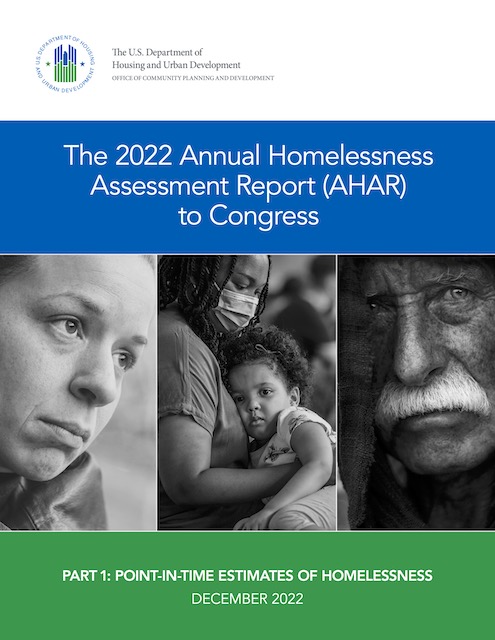Nearly 600,000 Americans were homeless in 2022, according to a report recently released by the Department of Housing and Urban Development (HUD). The department has been attempting to count homeless numbers each year since 2007, and the latest numbers are based on counts made in January 2022.
 Click image to download a 15.5-MB PDF of this 112-page report.
Click image to download a 15.5-MB PDF of this 112-page report.
According to HUD’s counts, the total number of homeless people in the U.S. grew by nearly 2,000 between 2020 and 2022 — but that’s just 0.3 percent and easily within the margins of error of the counts. HUD also estimates the number declined by more than 54,600 between 2010 and 2022, which is large enough to be more likely.
COVID and the associated increase in rental costs drove homelessness upwards, says HUD, which is strange because it says homelessness declined. But it claims that it declined because the American Rescue Plan included $1.1 billion in emergency housing vouchers, which sounds self-serving. The report never actually proves that those vouchers reduced homelessness, only that they increased the number of beds available for homeless people. In fact, as I understand it, the vouchers only would have reduced unsheltered homelessness, but people are still regarded as homeless even if they are in a temporary shelter.
The report is accompanied by spreadsheets showing the estimated number of homeless people from 2007 to 2022 by state and by each of 387 urban areas and rural regions (which the report calls “continuums of care”).
What the summary of the report doesn’t say is that homelessness may have increased by only 0.3 percent between 2020 and 2022, but it increased by 53 percent between 2021 and 2022 (which means they decreased by 35 percent between 2020 and 2021). Are these large swings of numbers due to poor counting methods or were large numbers of homeless people reclassified as not being homeless during the pandemic?
More interesting is the change in homeless numbers over a longer period of time. Between 2016 and 2022, homelessness increased by 6 percent nationwide, but it increased by 149 percent in Vermont, 121 percent in Delaware, 99 percent in Maine, 85 percent in Louisiana, 45 percent in California, 36 percent in Oregon and Rhode Island, 30 percent in South Dakota, and 21 percent in Washington, while it decreased in many other states. Does this mean that some states are doing the right things and others are doing the wrong things? Or are such wide divergences in growth just another example of inadequate counting methods?
A recent report found that Seattle spent nearly a billion dollars on helping homeless people in the last 11 years, yet the number of homeless grew. Are homeless people attracted to cities that are spending more money helping them? Social worker Kevin Dahlgren, who recently said that money spent on homelessness in Portland is “a colossal experiment gone bad,” probably thinks so.
Meanwhile, transit agencies such as the Twin Cities’ Metro Transit need to have “homeless action teams” to sweep the homeless out the way of customers who (the agency hopes) are actually paying fares. Metro Transit gives out housing vouchers, which shouldn’t be the job of a transit agency. “We’ve housed more than 350 people,” says a member of the transit police, not that this number means much when Minneapolis and St. Paul are estimated to have nearly 4,400 homeless people.
At the moment, I have more questions than answers. But I can’t help but think that whatever we are doing is going horribly wrong if the number of homeless people hasn’t really changed in the last 8 years. Instead of just throwing more money at the problem, as the Oregon legislature did last month, it’s time to change directions. Perhaps, if they are reliable, a close examination of the HUD data will help show what that new direction should be.








Google “Seattle is Dying”
https://www.google.com/search?q=seattle+is+dying&rlz=1C9BKJA_enUS963US963&hl=en-US&sxsrf=APwXEdcaWp8-dNoWKBHkF6pBXD-Vpb0ubw%3A1681375255382&ei=F8A3ZP78FtWq1QGw_ZmAAQ&oq=seattle+is+dying&gs_lcp=ChNtb2JpbGUtZ3dzLXdpei1zZXJwEAMyBAgjECcyBAgjECcyBAgjECcyBQguEIAEMgoIABCABBAUEIcCMgUIABCABDIFCAAQgAQyBQgAEIAEOgoIABBHENYEELADOgYIABAWEB46CAgAEIoFEIYDOgUIIRCgAToFCCEQqwJKBAhBGABQrhdYuyRgqzRoAnAAeACAAXKIAe0EkgEDNi4xmAEAoAEByAEIwAEB&sclient=mobile-gws-wiz-serp